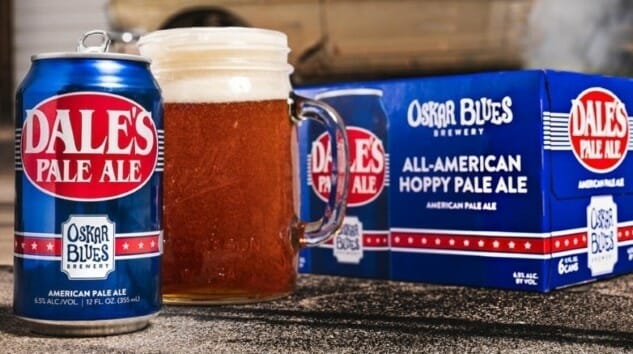My Month of Flagships: Oskar Blues Dale’s Pale Ale
Photos via Oskar Blues Brewing
This essay is part of a series this month, coinciding with the concept of Flagship February, wherein we intend to revisit the flagship beers of regional craft breweries, reflect on their influence within the beer scene, and assess how those beers fit into the modern beer world. Click here to see all the other entries in the series.
Prominent craft breweries that launched and grew into national fame during the early days of the second great beer boom—beginning the late ‘90s and continuing in the early 2000s—had a tendency to define themselves in a specific way. Whereas the first wave had perhaps catered to images of welcomeness, the great outdoors or regional pride, the second wave brewers tended to define themselves with attitude. These are the Stone Brewing Co.’s of the world we’re talking about here, or the Three Floyds. And yes, the Oskar Blues. Although they didn’t really cling to the same sort of combative, hardcore, “you’re not worthy” mantras of the likes of Stone or 3F, they did indeed project their own funky, thoroughly toasted mountain stoner energy into the beer scene. Few breweries have ever had such a firm grasp on their core identities as Oskar Blues, which is something you can say they’ve managed to maintain, even as a member of a private capital-owned “craft brewery collective” like CANarchy.
In the case of Oskar Blues, though, their iconoclasm extended to a choice that fundamentally altered how we drink craft beer, which isn’t something many breweries can claim. The decision to start putting Dale’s Pale Ale into cans in 2002 … well, you couldn’t possibly leave it off a list of the biggest moments in American brewing history. Although it may not have seemed like a revelation at the time, or even a decade later, it was the beginning of a trend in packaging that would become a dominant force within the industry, and one that is attached at the hip to some of the most sought-after styles in modern beer. Would hazy IPA ever have gained such a foothold, without the aid of 16 oz, gauzily labeled cans as its chosen vessel? And would those cans have ever become so universal, without the massive influence that was Dale’s? It’s easy to argue that no other brewery has done more for cans as a format (in styles such as imperial stout as well, via Ten Fidy), not only for that 2002 decision but for the subsequent Burning Can festival, which celebrated its 10th anniversary in 2019.
And so too was Dale’s simply an oddball of a beer when it arrived, especially for its designation as “pale ale.” Who, aside from the aforementioned Three Floyds, brews their pale ales at 6.5% ABV? Who packs them with 65 IBUs worth of bitterness? It was a beer that seemed like something intended as a shock to the system for those who had grown accustomed to “pale ale” as a friendly, approachable brewpub staple, and it quickly became a product associated with boisterous concert-goers and good-time-havers everywhere. After all: Cans were welcome in places that bottles never could be. That fact got Dale’s Pale Ale in through a lot of doors that might previously have been closed off to it, and Oskar Blues made the most of the exposure and headlines the beer generated.
Here in 2020, it’s safe to say that Dale’s has receded into the background a bit, surrounded by a lineup of vivacious, weed-referencing IPAs, stouts and seltzers—and a new series of lagers, thank god!—but there’s little doubt that it will always be considered the heart and soul of the brewery. It’s one of those flagships that engenders a lot of goodwill from beer geeks who recognize exactly how important it ultimately was to their favorite pastime.
So with that said, let’s re-taste some Dale’s and see how it’s drinking in 2020.